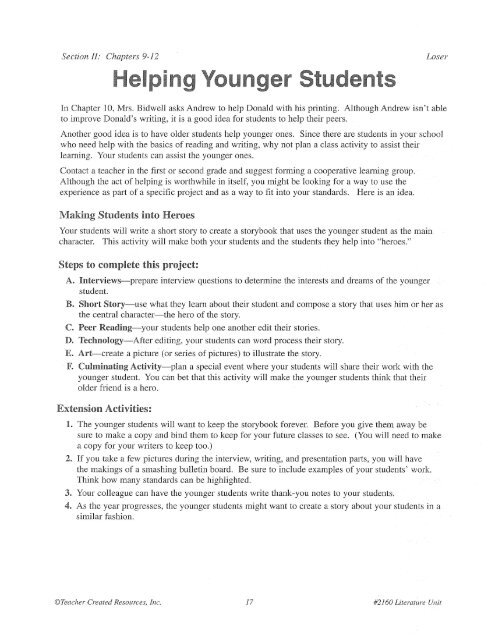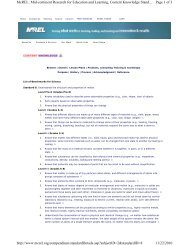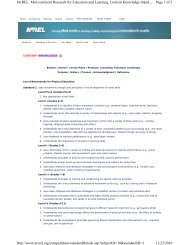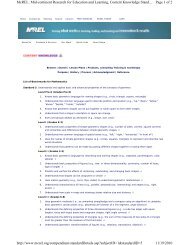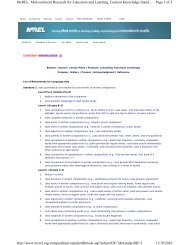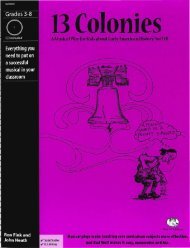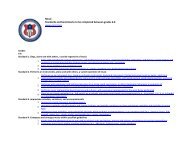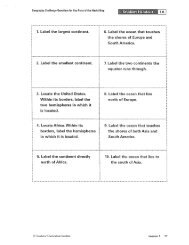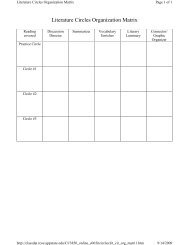Loser Activities Chapters 9-30.pdf
Loser Activities Chapters 9-30.pdf
Loser Activities Chapters 9-30.pdf
Create successful ePaper yourself
Turn your PDF publications into a flip-book with our unique Google optimized e-Paper software.
Section 11: <strong>Chapters</strong> 9-12 <strong>Loser</strong><br />
In Chapter 10, Mrs. Bidwell asks Andrew to help Donald with his printing. Although Andrew isn't able<br />
to improve Donald's writing, it is a good idea for students to help their peers.<br />
Another good idea is to have older students help younger ones. Since there are students in your school<br />
who need help with the basics of reading and writing, why not plan a class activity to assist their<br />
learning. Your students can assist the younger ones.<br />
Contact a teacher in the first or second grade and suggest forming a cooperative leanling group.<br />
Although the act of helping is worthwhile in itself, you Inight be looking for a way to use the<br />
experience as part of a specific project and as a way to fit into your standards. Here is an idea.<br />
Heroes<br />
Your students will write a short story to create a storybook that uses the younger student as the Inain<br />
character. This activity willInake both your students and the students they help into "heroes."<br />
Steps<br />
this project:<br />
A. Interviews-prepare interview questions to determine the interests and dreams of the younger<br />
student.<br />
B. Short Story-use what they leanl about their student and COlnpose a story that uses hiln or her as<br />
the central character-the hero of the story.<br />
C. Peer Reading-your students help one another edit their stories.<br />
D. Technology-After editing, your students can word process their story.<br />
E. Art-create a picture- (or series of pictures) to illustrate the story.<br />
F. Culminating Activity-plan a special event where your students will share their work with the<br />
younger student. You can bet that this activity wililnake the younger students think that their<br />
older friend is a hero.<br />
1. The younger students will want to keep the storybook forever. Before you give them away be<br />
sure to make a copy and bind them to keep for your future classes to see. (You will need to Inake<br />
a copy for your writers to keep too.)<br />
2. If you take a few pictures during the interview, writing, and presentation parts, you will have<br />
the Inakings of a slnashing bulletin board. Be sure to include exanlples of your students' work.<br />
Think how many standards can be highlighted.<br />
3. Your colleague can have the younger students write thank-you notes to your students.<br />
As the year progresses, the younger students might want to create a story about your students in a<br />
Si111ilar fashion.<br />
©Teacher Created Resources, Inc. 17 #2160 Literature Unit
Section 11: <strong>Chapters</strong> 9-12 <strong>Loser</strong><br />
One of Donald's most obvious characteristics is his positive attitude. It is Donald's view or perception of<br />
life that creates this attitude. Perhaps you've heard the famous saying by Abrahan1 Lincoln, "People are<br />
just as happy as they luake up their Ininds to be." Donald simply enjoys being happy. Andrew, Donald's<br />
next-door neighbor, seen1S to be much the opposite. His view or perception of life is negative.<br />
With a partner discuss the following and decide on the best answer for the following questions about<br />
perceptions. Write your cooperative answers on the lines.<br />
1. Donald really enjoys school. What are sonle of the ways the reader can see this?<br />
2. Mrs. Bidwell's perception of school is negative. What are some of the ways you can tell?<br />
Finish the following statements showing how the situation can have a positive as well as a negative<br />
perception.<br />
3. I an1 looking forward to the math test since<br />
4. I aIn dreading the Inath test because<br />
5. Our physical education program at this school is great since<br />
6. Our physical education prognnn at this school is horrible because<br />
Write the answer to these last two activities on another sheet of paper.<br />
7. COlnpose a paragraph about the positive and negative aspects of the last novel your class read.<br />
8. What conclusions can you nlake about positive and negative perceptions? Consider Abraham<br />
Lincoln's quote in your answer.<br />
#2160 Literature Unit 18 ©Teacher Created Resources, Inc.
Section 11: <strong>Chapters</strong> 9-12 <strong>Loser</strong><br />
Donald has a wonderfully positive outlook. He is almost always smiling and laughing. Did you know<br />
that there is scientific evidence that proves that laughing ilnproves your body's well-being? Consider<br />
these three different levels:<br />
1. Laughter ilnproves the flow of oxygen to your organs. By the convulsive movelnents you have<br />
during laughing, oxygen moves around your body. This boosts your immune system and helps<br />
clear out old, dead waste products from organs and tissues. This lnovelnent helps to sustain life<br />
and fight off disease.<br />
2. Laughter boosts our mental ability. The lnore oxygen flowing to your brain gives you a better<br />
ability to concentrate. All that laughing at recess can help with lessons when getting back to<br />
class.<br />
3. Laughing is good exercise. Have you ever laughed so much that your stOlnach hurt? This is smne<br />
serious exercise. This exhaustion has the smne effect as a physical workout program.<br />
Here's an hypothesis to consider: One scientific researcher said that every minute of laughter produces<br />
around $10,000 worth of healthy body chemicals! He says that there is a long list of chelnicals created<br />
by laughter, including serotonin. If you tried to purchase these chemicals at a store they would costyou<br />
a fortune.<br />
Now that we know smne of benefits of laughing, the following two exercises could be worth even lnore<br />
than just having a great time.<br />
1. Make a list of the things that typically make you laugh, especially when you are having a "bad"<br />
day. For the next two days create a list of the things that 111ake you laugh.<br />
2. For a journal topic, use your research on laughing to explain how enjoying a good laugh lnakes<br />
you feel better about<br />
a) getting out of bed on a school day<br />
b) doing chores around the house<br />
c) dealing with an upcOlning test<br />
d) dealing with smneone who has trouble understanding what you are explaining<br />
©Teacher Created Resources, Inc. 19 #2160 Literature Unit
Section 11: <strong>Chapters</strong> 9-12 <strong>Loser</strong><br />
Donald's father is a postal catTier. We get a good idea of how Mr. Zinkoff's views his job when he<br />
takes Donald to "work" one Sunday. When we reseat-ch occupations, we get a new understanding and<br />
appreciationof the work people do.<br />
This activity will give you the opportunity to research an occupation of your choice.<br />
I. Write down occupations of SOlne people you know.<br />
II. Which one of these occupations would you enjoy knowing Inore about?<br />
III. Internet and/or research (locate answers to the following ques~ions):<br />
a. What nlakes this occupation important to our society?<br />
b. How l1luch education do you need to get this job?<br />
c. What is the comnlon salary of this occupation?<br />
d. Is this an occupation that is easily done in your area, or where lnight you have to move to do<br />
it?<br />
e. Is this Inore of a physical or Inental job? Explain.<br />
f. What are SOlne of the interesting elements of this occupation?<br />
g. What are some of the drawbacks?<br />
h. Would you wish to find out Inore about this occupation for your future? Why?<br />
Report your findings to the class.<br />
#2160 Literature Unit 20 ©Teacher Created Resources, Inc.
Section III: <strong>Chapters</strong> 13-18<br />
<strong>Loser</strong><br />
The longest sequence in the novel so far is when Donald tries to overcome his fear of the funlace in<br />
the dark and creepy cellar. If you reread this section in the chapter you see that Spinelli creates a vivid<br />
picture of Donald,ls experience. He Inakes us understand what is happening by appealing to three of<br />
our five senses-sight, sound, and touch. It is a scene that would work well in a lnovie.<br />
Pretend you are an art director of a fihn and draw a picture of what you think a scene of the basement<br />
sequence would look like. Use the space below to make a rough drawing which you can later complete<br />
on another sheet of paper. You might consider a 3-dilnensional representation. Can't you see the<br />
furnace in 3-D? Try to use SOlne of the elements that Spinelli presents in words in your visual creation.<br />
#2160 Literature Unit 22 ©Teacher Created Resources, Inc.
Section 111: <strong>Chapters</strong> 13-18 <strong>Loser</strong><br />
Donald has a 1110ther and father who supp01i his special abilities and positive outlook. He always<br />
knows, even after the horrible experience of Field Day that they will be there to help give him what he<br />
needs.<br />
In this activity, work with a paIiner to answer the questions about <strong>Loser</strong> and then discuss and write<br />
down S0111e of your thoughts about how parents can best support their children.<br />
1. At the end of Chapter 16, how does Donald know that his dad will "never give up on hilll"?<br />
2. In chapter 17, how does Donald's 1110111 show she respects his feelings when she is getting ready<br />
for the garage sale?<br />
3. As we get older, our parents supp01i us in different ways than they did when we were first<br />
beginning school. What are some things that your parents used to help you with that you can now<br />
do on your own?<br />
What is a problel11 (or two) that a person in your grade would want to discuss with their parents?<br />
What kind of parental support would be n10st helpful with this paIiiculaI' problem?<br />
©Teacher Created Resources, Inc. 23 #2160 Literature Unit
Section III: <strong>Chapters</strong> 13-18<br />
I<br />
<strong>Loser</strong><br />
In chapter 13, Spinelli writes this si111ile, "ti111e sits on Zinkoff's hands like an elephant." This refers<br />
to how difficult it was for Donald to sit and wait, and it leads to his adventures in the dark and scary<br />
cellar.<br />
A sinlile cOlllpares two things or objects that have little in C01111llon. To be a proper simile it must use<br />
"like" or "as" in its construction. A clever simile can bring a clear understanding to the situation. The<br />
heaviness of an elephant seelllS a perfect comparison to how difficult it is for Donald to wait.<br />
Animal sinliles are common. In fact, there are few people who haven't heard that "she is as curious<br />
as a cat" or "he eats like a horse." Fill in the blanks below with the anin1al you think would be n10st<br />
cOlllmonly used for that sinlile. A list of the anilnals used are in the word box.<br />
Word Box<br />
dog lllouse lark<br />
bat owl snail<br />
bunny mule eel<br />
bee lan1b ox<br />
1. You must speak up. You are as quiet as a _<br />
2. I have a fever and want to go back to bed. I am as sick as a _<br />
3. I couldn't grab the spoon. It was as slippery as an<br />
4. Ask George to help you lift the heavy box. He is as strong as an<br />
5. Alice beats everyone in the 50-yard dash. She's as quick as a<br />
6. Please don't bother TIle right now. I'lll as busy as a<br />
7. The teacher will know the answer. He is as wise as an _<br />
8. Wait until you go on the haunted house ride. You'll be as blind as a _<br />
9. I've been waiting for the elevator for five n1inutes. It's as slow as a<br />
10. Don't worry about him. He is as gentle as a<br />
11. You'll never get your brother to change his Blind. He's as stubborn as a<br />
12. She is always in such good spirits. I'd say she is as happy as a<br />
#2160 Literature Unit 24 ©Teacher Created Resources, Inc.
Section III: <strong>Chapters</strong> 13-18 <strong>Loser</strong><br />
In this section, Donald wants a best friend. He never has thought that l11uch about it until he had to<br />
fill in blanks on a test. He chooses Hector Binns. Of course, we know a best friend is not chosen.<br />
Sometin1es, creating a best friend is difficult. However, studies have shown there are some key<br />
elements that 111ake good friendships work.<br />
To have good friends you must be a good friend. Here are SOl11e of the ways good friends treat each<br />
other:<br />
.. Good friends listen to one another.<br />
Section IV: <strong>Chapters</strong> 19-23 <strong>Loser</strong><br />
Donald Zinkoff has found it difficult to make friends. People view hilU as different. Although he is<br />
loved at home, and his parents think he is just fine, at school he is an outsider. Even the teachers have<br />
trouble accepting Donald.<br />
It is important to each of us to be accepted. We are concerned that others, especially those people our<br />
own age, see as "one of the group." In order to be accepted we must sOluetilues act in a way that is<br />
really not the way we feel or believe. When we consider it seriously, we know that it is the differences<br />
that luake the world a luore interesting place. Do we want a world where everyone acts the same? Do<br />
we want to live in a world where everyone looks the saIue? Differences enrich our lives.<br />
In groups of three or four, list some of the differences you can find aJuong those in your group. After<br />
you have completed your list, discuss how these differences luake you and your classmates luore<br />
interesting.<br />
Here are some categories to help get the group started.<br />
Physical Characteristics<br />
III<br />
III<br />
III<br />
III<br />
Talents<br />
skin color<br />
eye color<br />
hair length and color<br />
height<br />
Favorite school subjects<br />
Fanlily Size (nulubers of brothers and sisters)<br />
Birth Order<br />
Favorite Possessions<br />
Parents' Jobs<br />
Hobbies<br />
Fears<br />
Favorite Foods<br />
Sports Played<br />
Have your group come up with four or five other categories and then list your differences for each one.<br />
#2 J60 Literature Unit 28 ©Teacher Created Resources, Inc.
Section IV: <strong>Chapters</strong> 19-23 <strong>Loser</strong><br />
Donald is learning to deal with disappointlnent in his life. He has been a happy child, but now it is<br />
impOliant for him to feel Inore accepted by his peers. Each of us must learn how to cope when life<br />
isn't what we wish it to be. I-Iere are S0I11e ways of keeping disappointment fronl getting you down.<br />
Section V:. <strong>Chapters</strong> 24-30 <strong>Loser</strong><br />
In Lose1', Jerry Spinelli wants the reader to consider how each of us is dif-ferent and that those<br />
differences are what ll1ake us unique. Donald Inay not be like most of the others in his class, but he<br />
should be recognized for his special qualities.<br />
To the Teacher: In these exercises, students will be able to recognize positive traits in themselves and<br />
others and develop a habit of talbng about positive traits.<br />
Discuss the concept of a positive or negative atmosphere in the classroOln and how it affects how we<br />
feel about each other. A negative atlnosphere is created when students and teachers use put-downs,<br />
pointing out only negatives qualities. A positive atmosphere is created when we look for and talk about<br />
the good qualities. Create this positive atlnosphere by practicing 'put-ups!'<br />
Procedure:<br />
1. Use this daily exercise for 10 to 15 minutes for a week or more.<br />
Z. Seat students in a circle facing each other.<br />
3. Explain "Sharing Circle" rules as follows:<br />
Students take tutTIS, going around the circle until everyone has spoken. One person speaks at a<br />
tinle.<br />
No interruptions, laughing at, or conllnents allowed.<br />
Listen to the person who is speabng.<br />
When it is your turn, share one brief answer on the topic given.<br />
4. Write the topic on the chalkboard, say it loud, then allow a Ininute or Inore for your students to<br />
think before beginning the circle.<br />
rropics:<br />
Day 1: "Son1ething that I like in other people is..." (Suggested examples: "I like people who are<br />
honest." I like people who listen to me.")<br />
Day 2: "SOlnething I like in Inyself is ..." (Examples: "I like that I'm smart. I can keep a secret")<br />
Day 3: "Son1ething I like or appreciate about the person to Iny right is... " (Exmnples: She is funny.<br />
He is friendly. He draws pictures for Ine." Emphasize that all COlnments lnust be 'put-ups.')<br />
Day 4 and on: "Who can relnelnber a tillie when (supply student's nanle) did something very special<br />
and caring for SOlneone in class? (You can begin by filling in an example about one of your students.<br />
Encourage students to relate the special deeds children have done in class or on the playground.)<br />
You lnight want to have each student name a positive characteristic that his or her exmnple shows:<br />
Courage Enthusiasrrl Strength (of character)<br />
Joy Understanding Caring<br />
Trust Honesty Support<br />
Display these appreciations in the classrOOln. You nught want to create a tree where each leaf is one of<br />
the 'put-ups.' You'll celiainly want to be sure that every student in the classroom is represented.<br />
©Teacher Created Resources, Inc. 33 #2160 Literature Unit
Section v:- <strong>Chapters</strong> 24-30 <strong>Loser</strong><br />
In this story, Donald goes through l11any changes. We also go through changes as we go through our<br />
lives. Think about what you are like now. How have you changed since you were a young child?<br />
What will you be like when you graduate fr0111 high school? What will you be like ten years after<br />
graduating from high school? Use the spaces below to show yourself at four different stages of life.<br />
Then, on the back of this paper, write a paragraph telling about some of your goals for the future.<br />
(as a young<br />
ME (as I am right now)<br />
I school) (ten years after graduating)<br />
©Teacher Created Resources, Inc. 35 #2160 Literature
After the Boo/(<br />
<strong>Loser</strong><br />
Many thoughts and images nm through our Imnds at ahnost any mOlnent. There are things we choose<br />
to think about and others that are involuntary. A well-written fictional character comes alive to us in<br />
the ways he or she think, (as well as act). Choose an ilnportant incident in <strong>Loser</strong> and consider it frOln<br />
Donald's point of view. Inside the silhouette below, visually represent Donald's thoughts through<br />
words and/or pictures.<br />
#2160 Literature Unit 36 ©Teacher Created Resources, Inc.
After the Book<br />
<strong>Loser</strong><br />
W11en you finished reading <strong>Loser</strong>, you probably had S0111e questions that were left unanswered. Write<br />
theln on the back of this page. Then work in groups or by yourself to prepare possible answers for the<br />
questions you have asked or for those written below. When you have finished, share your ideas with<br />
the class.<br />
1. Does the Waiting Man ever stop waiting for his brother to return fr0111 VietnaI11? Why or why<br />
not? ~<br />
2. Do the Waiting Man and Donald ever have a conversation? If so, what do they talk about?<br />
3. Does Donald continue to see Claudia and her l11other? _<br />
4. Do Donald and Hector Binns see each other in l11iddle school? Do they become friends?<br />
5. Does Donald ever have a best friend?What is he or she like? ---------------<br />
6. What interests does Donald develop in high school?<br />
7. Does Donald ever leanl to l11arch and play the flute at the SaI11e time? Why or why not?<br />
8. Does Donald ever go back and see Mr. Yalowitz? Why or why not?<br />
9. Does Donald reI11el11ber the number 2,160 on the day he graduates fr0111 high school? How does<br />
he react?<br />
_<br />
10. When is Donald able to go down into the cellar and not be afraid?<br />
11. Does Donald bec0111e a l11ailman like his father? Why or why not?<br />
12. If he doesn't become a mailI11an, what occupation does Donald have?<br />
©Teacher Created Resources, Inc. 37 #2160 Literature Unit
Culminating Activity<br />
<strong>Loser</strong><br />
One of Donald's favorite words is TINTINNABULATION. He heard it on the first day of first grade<br />
and never forgot it. The word is used the l11arvelous poel11, The Bells by Edgar Allan Poe. It is toward<br />
the end of the first stanza.<br />
Here's sOll1ething you can use as a choral reading for your class. There are so many wonderful new<br />
words to learn, and when they understand the use of rhythms they will keep them the rest of their lives.<br />
And, of course, they, too, will never forget TINTINNABULATION!!<br />
Here are some ideas to use in your choral reading.<br />
1. The poel11 is divided into four stanzas, each celebrating a different size bell: sleigh bells, wedding<br />
bells, alarm bells, funeral bells. Divide your class into four sections.<br />
2. The constant repetition of the word 'bells' is to sill1ulate the back and fOlih movement of the<br />
clapper inside the bells. Without that ll10venlent there would be no sound. Have the whole class<br />
join in on the word "bells."<br />
3. Each successive bell has a lower sound. You ll1ight have the higher voices on the first two stanzas<br />
and the lower voices on the last two. Having students learn to speak together so they can be heard<br />
is till1e consuming. You probably will want to divide the lines so that each student has two or<br />
three. The l11eaning in the lines divide easily into two or three line segl11ents. Exanlple of the first<br />
stanza:<br />
Hear the sledges with the bells<br />
Silver bells!<br />
What a world of nlerriment their melody<br />
foretells!<br />
How they tinkle, tinlde, tinkle,<br />
In the icy air of night!<br />
While the stars that over sprinkle<br />
All the heavens, seem to twinkle<br />
With a crystalline delight;<br />
(II<br />
Keeping til11e, til11e, tillle,<br />
In a SOli of Runic rhyl11e,<br />
To the tintinnabulation that so musically wells<br />
(these lines the class does together)<br />
FrOlll the bells, bells, bells, bells,<br />
Bells, bells, bells,<br />
From the jingling and the tinkling of the bells<br />
4. It is a choral reading, not a nleillorization exercise. SOll1e of your students will, undoubtedly<br />
ll1elllorize, but unless you have an especially adept class, don't ll1ake this a requirement. The idea<br />
is to work together to create an effect. Meillorization will get in the way of a finished product.<br />
Give each student his or her own copy of the poel11 to use while practicing and in perfornlance.<br />
5. Find a recording of the poem to play for your class. This will help them get the words and<br />
rhythll1S. One can be found atwvvw. reelyredd.cOln.<br />
6. Ask the nlusic teacher if he or she would like to nlake this a joint effort.<br />
7. There are so nlany ways you can teach poetry through this poel11. One of the figures of language<br />
used is onOll1atopoeia (which your students will also love to say). Have them find those imitatingthe-sound-they-make<br />
words like jingling, tinkling, clang, clash, roar and explain how they add to<br />
the poel11's effect. Then have thel11 find onomatopoeic words in their own life.<br />
8. Perfonl1 for other classes and parents. Have fun!!<br />
#2160 Literature Unit 40 ©Teacher Created Resources, fnc.
Cubninating Activity<br />
<strong>Loser</strong><br />
by<br />
Edgar Allarl Poe<br />
I<br />
Hear the sledges with the bells <br />
Silver bells!<br />
What a world of merriment their<br />
melody foretells!<br />
How they tinkle, tinkle, tinkle,<br />
In the icy air of night!<br />
While the stars that oversprinkle<br />
All the heavens seem to twinkle<br />
With a crystalline delight;<br />
Keeping time, time, time,<br />
In a sort of Runic rhyme,<br />
To the tintinnabulation that so<br />
musically wells<br />
From the bells, bells, bells, bells,<br />
Bells, bells, bells -<br />
From the jingling and the tinkling of<br />
the bells.<br />
H<br />
Hear the mellow wedding bells <br />
Golden bells!<br />
What a world of happiness their<br />
harmony foretells!<br />
Through the balmy air of night<br />
How they ring out their delight!<br />
From the molten-golden notes,<br />
And all in tune,<br />
vVhat a liquid ditty floats<br />
To the turtle-dove that listens, while<br />
she gloats<br />
On the moon!<br />
Oh, from out the sounding cells<br />
What a gush of euphony voluminously<br />
wells!<br />
How it swells!<br />
How it dwells<br />
On the Future! -how it tells<br />
Of the rapture that impels<br />
To the swinging and the ringing<br />
Of the bells, bells, bells,<br />
Of the bells, bells, bells, bells,<br />
Bells, bells, bells -<br />
To the rhyming and the chiming of the<br />
bells!<br />
HI<br />
Hear the loud alarum bells <br />
Brazen bells!<br />
What a tale of terror, now, their<br />
turbulency tell s!<br />
In the stmtled ear of night<br />
How they scream out their affright!<br />
Too much horrified to speak,<br />
They can only shriek, shriek,<br />
Out of tune,<br />
In a clamorous appealing to the mercy<br />
of the fire,<br />
In a mad expostulation with the deaf<br />
and frantic fire,<br />
Leaping higher, higher, higher,<br />
With a desperate desire,<br />
And a resolute endeavor<br />
Now -now to sit or never,<br />
By the side of the pale-faced moon.<br />
Oh, the bells, bells, bells!<br />
What a tale their terror tells<br />
Of despair!<br />
How they clang, and clash, and roar!<br />
What a horror they outpour<br />
On the bosom of the palpitating air!<br />
Yet the ear it fully knows,<br />
By the twanging<br />
And the clanging,<br />
How the danger ebbs and flows;<br />
Yet the ear distinctly tells,<br />
In the jangling<br />
And the wrangling,<br />
How the danger sinks and swells,<br />
By the sinking or the swelling in the<br />
anger of the bells -<br />
Of the bells,<br />
Of the bells, bells, bells, bells,<br />
Bells, bells, bells -<br />
In the clamor and the clangor of the<br />
bells!<br />
IV<br />
Hem the tolling of the bells <br />
Iron bells!<br />
What a world of solemn thought their<br />
monody compels!<br />
In the silence of the night,<br />
How we shiver with affright<br />
At the melancholy menace of their<br />
tone!<br />
For every sound that floats<br />
From the rust within their throats<br />
Is a groan.<br />
And the people -ah, the people <br />
They that dwell up in the steeple,<br />
All alone,<br />
And who tolling, tolling, tolling,<br />
In that muffled monotone,<br />
Feel a glory in so rolling<br />
On the human heart a stone -<br />
They are neither man nor woman <br />
They are neither brute nor human <br />
They are Ghouls:<br />
And their king it is who tolls;<br />
And he rolls, rolls, rolls,<br />
Rolls<br />
A paean from the bells!<br />
And his merry bosom swells<br />
With the paean of the bells!<br />
And he dances, and he yells;<br />
Keeping time, time, time,<br />
In a sort of Runic rhyme,<br />
To the paean of the bells,<br />
Of the bells -<br />
Keeping time, time, time,<br />
In a sort of Runic rhyme,<br />
To the throbbing of the bells,<br />
Of the bells, bells, bells -<br />
To the sobbing of the bells;<br />
Keeping time, time, time,<br />
As he knells, knells, knells,<br />
In a happy Runic rhyme,<br />
To the rolling of the bells,<br />
Of the bells, bells, bells -<br />
To the tolling of the bells,<br />
Of the bells, bells, bells, bells,<br />
Bells, bells, bells -<br />
To the moaning and the groaning of the<br />
bells.<br />
©Teacher Created Resources, Inc.<br />
41<br />
#2160 Literature Unit
CUI17Zinatillg ActiVity<br />
When At theheend first ofChapter heill'd each27, ofthem, Donald starts to halIucinate because ofthe cold and his eXhaustion. He.<br />
still1s<br />
tlunkmg aud talking about his Past. For each ofthe fOllOWing, connect to the moment in the nOvel<br />
<strong>Loser</strong><br />
IIpiece of cak.e"<br />
((Go Donald!))<br />
#2160 Literature Unit<br />
42<br />
©Teacher CreatedRqources, Inc.
Unit Test: Option 2<br />
<strong>Loser</strong><br />
On a separate piece of paper, explain a possible 111eaning of each of these quotations fr0111 <strong>Loser</strong>. Try to<br />
find a unique meaning "behind' the words.<br />
Chapter 1: "You grow up with a kid but you never really notice hil11."<br />
Chapter 3: "Burping, growing, throwing, running-everything is a race."<br />
'!hIJ>T1i..t.c n4 5: "What a wonderful adventure it will be!"<br />
Chapter 6: "Even when you yourself are not in a particular place, your nal11e can be there."<br />
""-"lnTLJ"~<br />
7: "He keeps erupting through dinner. Eating bec0111es hazardous."<br />
Chapter 8: "Early on, Zinkoff's mother impressed upon her son the etiquette of throwing up."<br />
Chapter 9: "Zinkoff is determined to becollle a better loser."<br />
Chapter 10: "It is the Rolls Royce of greenboard erasers."<br />
Chapter 13: "His world shrinks to the living-ro0111 sofa."<br />
Chapter 14: "A smear oflight puddles at the far corner of the furnace."<br />
Chapter 15: "Big-kid eyes are picky."<br />
Chapter "He knows that if he ever springs a leak or throws a gasket, his dad will be there with<br />
duct tape and chewing gun1 to patch hil11 up, that no nlatter how much he rattles and knocks, he'll<br />
always be a honeybug to his dad, never a clunker."<br />
Chapter 18: "His eyes have gone back to the Beyond."<br />
Chapter 20: "The town is the same and not the Sal11e."<br />
Chapter 21: "Like stones, he drops each sound into those uncrying eyes."<br />
Chapter 22: "Boondocks forever."<br />
Chapter 23: "Long before the first snowfall, he sinks into nobodyness."<br />
Chapter 25: "The light fr0111 the nearest streetlal11p follows him, loses him."<br />
Chapter 26: "He wonders if angels are invisible in the snow. He wonders if angels make people in the<br />
snow."<br />
Chapter 28: "She (Claudia's mother) just sits on the sofa and pulls hil11 into herself and won't let him<br />
go."<br />
Chapter 30: "... but in the end there's really only one word, he (Bonce) knows that, one word fron1<br />
him and who knows where we go from there?"<br />
#2160 Literature Unit 44 ©Teacher Created Resources, Inc:
Unit Test: Option 3<br />
<strong>Loser</strong><br />
Work in size-appropriate groups to write and perform the conversations that Inight have occurred in the<br />
following situations. If you prefer, you may use your own conversation idea for characters frOln <strong>Loser</strong>.<br />
* Mr. and Mrs. Zinkoff have a talk about Donald the day before he begins first grade. (2 people)<br />
* Mrs. Bidwell tells her husband about Donald after the first day of second grade. (2 people)<br />
* The principal and Mrs. Bidwell discuss the situation after he finds out she sent Donald hOlne.<br />
(2 people)<br />
* Andrew and his mother argue when he walks into the house with Donald's trophy. (2 people)<br />
* Donald tells Mr. Yalowitz what it means to sit in the front of the classroom. (2 people)<br />
* Donald and his dad discuss what happened at the fourth grade Field Day. (2 people)<br />
* Donald and Claudia's n10ther have a longer discussion about the value of the leash. (2 people)<br />
* Hector Binns gives details to Donald about how he will n1ake his ear-wax candle. (2 people)<br />
* Mr. and Mrs. Zinkoff, Donald, and Polly chat about the graduation cerelnony on the way hOlrte in<br />
the car. (4 people)<br />
* Donald and Mr. and Mrs. Zinkoff talk in detail about what happened to Donald while he was<br />
looking for Claudia. (3 people)<br />
* Donald and Claudia's mother have a talk when she COlnes to see hiln after his experience in the<br />
snow. (2 people)<br />
In the future:<br />
o<br />
* Donald goes back to see Mr. Yalowitz to get son1e ideas about how to handle middle school. (2<br />
people)<br />
~l~ In high school, Andrew and Donald have a class together. They begin to be friendly. What 111ight<br />
they talk about? (2 people)<br />
* Mr. and Mrs. Zinkoff and Donald have a discussion the day of Donald's high school graduation.<br />
(3 people)<br />
©Teacher Created Resources, Inc. 45 #2160 Literature Unit
Abbot, Tony. Firegirl. (Little Brow, 2006)<br />
Avi. Cri,~]Jin: The Cross ofLead. (Hyperion, 2002)<br />
Bradby, Marie. Some Friend. (Atheneum, 2004)<br />
Choldenko, Gennifer. Al Capone Does My Shirts. (Puffin, 2006)<br />
Creech, Sharon. Heartbeat. (Joanna Colter, 2004)<br />
---vValk T'vvoMoons. (HarperTrophy, 1996)<br />
Crutcher, Chris. Staying }teltfor Sarah Byrnes. (Greenwillow, 1993)<br />
DiCamillo, Kate. Because ofWinn-Dixie. (Candlewick, 2000)<br />
Dowell, Frances O'Roark. Chicken Boy. (Antheneum, 2005)<br />
Going, K.L. the Liberation ofGabriel King. (Putnam, 2005)<br />
Henkes, Kevin. Olive's Ocean. (Greenwillow, 2003)<br />
Kadohata, Cynthia. Kira-Kira. (Antheneum, 2004)<br />
Lowry, Lois. The Givel: (Walter Lorraine, 1993)<br />
Paulsen, Gary. Harris and Me: A SUl111ner RenzeJnbered. (Harcourt, 1993)<br />
Sacher, Louis. Holes. (Foster, 1998)<br />
Spinelli, Jerry. Maniac Magee. (HarperTrophy, 1990)<br />
---Stargirl. (Knopf, 2000)<br />
---vVringer. (Joanna Colter, 1997)<br />
Tasjian, Janet. The Gospel According to Larry. (Henry Holt, 2001)<br />
Nonfiction<br />
Beckham, David. David Beckhaln 's Soccer Skills. (HarperCollins, 2007)<br />
Booher, Dianna. Making Friends with Yourse(f & Other Strangers. (Messner, 1982)<br />
Crisfield, Deborah W. 17w Everything Kids' Soccer Book. (Adams Media, 2002)<br />
Crisswell, Patti Kelly. A Snwrt Girl's Guide to Friendship Troubles. (An1erican Girl, 2003)<br />
Cohen, Susan and Donald Cohen. Teenage Stress. (Evans, 1984)<br />
Herron, Ronald W. A Good Friend: How to Make One, How to Be One. (Boys Town Press, 1998)<br />
Kennedy, Rod. Monopoly: The Story Behind the World's Best Selling Game. (MJF, 2006)<br />
Orbanes, Philip. The Monopoly Companion: the Player's Guide. (Sterling, 2007)<br />
Varenhorst, Barbara. Real Friends: Becoming the Friend You'd Like to Have. (Harper, 1983)<br />
Ward, Hiley. Feeling Good About Myself (Westminster, 1983)<br />
For Teachers:<br />
Cook, Mark. Levels ofPersonality. (Continuun1 Press, 1993)<br />
Danzig, Robeli J.<br />
AlTIerica, 2003)<br />
There is Only One You: You Are Unique in the Universe. (Child Welfare League of<br />
Harris, Judith. No Two Alike: Human Nature and Hzunan Individuality. (NOlion, 2006)<br />
Lerner, Stephanie. Kids Who Think Outside the Box. (AMACOM, 2005)<br />
Thomas, Alexander. Behavioral Individuality in Early Childhood. (Greenwood, 1980)<br />
Tobias. Cynthia Ulrich. The VV{zy They Learn. (Tyndale House, 1998)<br />
#2160 Literature Unit 46 ©Teacher Created Resources, Inc.
Section IV- <strong>Chapters</strong> 19-23<br />
<strong>Loser</strong><br />
Donald Zinkoff practiced hard to be good at the Field Day relays. Relays are fun. Try some of the<br />
ones listed below. Perhaps your class will enjoy thein so Inuch that you want to plan your own Field<br />
Day.<br />
'"<br />
Provide each tearn with balloons-you'll need one per team menlber plus a couple<br />
of nlore, just in case. Inflate the balloons, so each is about the sarne size. Set up a chair for each<br />
team at a destination point. As the relay begins, the first Iuenlber of the team carries a balloon<br />
to the chair, puts the balloon on the chair, and then sits on the balloon until it pops. When the<br />
balloon pops, the student runs back to his or her team and tags the next person in line. The relay<br />
continues until the last student in each tearu has made it back to the line. The first team to finish<br />
WIns.<br />
Suitcase Madness: Provide each team with a suitcase of old clothes, containing a pair of<br />
oversized pants, an oversized shirt, and large shoes. (If you really want hysterical students,<br />
include colorful boxer shorts and an outrageous hat.) When the relay begins, the first meIuber of<br />
each team runs to the destination spot with suitcase in hand, opens the suitcase, and puts on each<br />
of the clothing items over his or her own clothing. When that student is fully dressed, he or she<br />
undresses, packs up the suitcase, and runs back to the team. He or she then hands off the suitcase<br />
to the next student and the relay continues... The relay ends when the last student returns to the<br />
tearll with the packed-up suitcase. The tearll that finishes fastest wins. (You might have each pose<br />
while dressed while a photo is taken.)<br />
• Orange You Having Fun?? Teams stand in a line with the first nlember of the tearu holding<br />
an orange (or other sinlilar'-sized fruit.) The objective is to pass the orange down the line to the<br />
last teanllueluber without using their hands. This is done by gripping the orange under your<br />
chin (renlember, no hands!), then turning around to face the next person and for them to take the<br />
orange fr01u you by gripping it under their chin. This process is repeated down the line to the last<br />
person. Either stop the relay at this point or have the last person run to the front and start again.<br />
The race stops when the first person ends up at the front again. If you drop the orange while<br />
passing it, you must start over with the first person!<br />
@<br />
Don't Egg Us On! Each player has to run balancing an egg (raw or hard boiled) on a spoon. (Or,<br />
if you prefer, use marbles.) If the object falls off the spoon, players have to stop, pick it up and<br />
replace it before running on again to a destination point and back to the next in line.<br />
@<br />
MunlnlY!! You'll need plenty of econ01UY toilet-paper rolls. One team Iuelnber is nominated to<br />
stand perfectly still. Other team Illembers then have to wrap hilU or her up so they look like an<br />
Egyptian nlunlmy. Points awarded for first to finish and points to best-dressed l11umlllY.<br />
Try this variation and have teams of 6. Each meinber wraps one body part: ann (2), leg (2),<br />
head-there should be only one of those!<br />
©Teacher Created Resources, Inc. 29 #2160 Literature Unit
Section V' <strong>Chapters</strong> 24-30 <strong>Loser</strong><br />
At the end of the novel there is an interesting scene where Bonce picks Donald to be on his football<br />
teaIn. At first, the boys make fun of Donald. However, Donald refuses to leave, and eventually Bonce<br />
calls his name. The events of the previous days-looking for Claudia and everyone cOIning to see<br />
him-has made Donald feel good about himself again. We again see all the special qualities that make<br />
Donald the unique person he is.<br />
You also have many abilities and interests that Inake you the special person you are. Each personin<br />
your class is special in his or her own way.<br />
To celebrate these qualities, you can create a class quilt. Each Inelllber will have a square that will<br />
reveal his or her individuality.<br />
Materials:<br />
<br />
Create a Class<br />
8 Yz inch (22 cm) squares of white paper - one for<br />
each student<br />
.. lO-inch (25 cm) square pieces of construction<br />
paper, various colors<br />
<br />
magazines, scissors, and glue<br />
lil<br />
111arkers, crayons, and other ali supplies<br />
.. a roll of wide l11asking tape<br />
Each student gets a piece of white paper on which to create an art work that shows his or her interests,<br />
thoughts, future plans, or whatever he or she wants. Students can use ali supplies or create a collage by<br />
cutting pictures out of magazines.<br />
After the students have completed their artwork, have each select a piece of construction paper. Ask<br />
them to glue their artwork in the middle so the construction paper creates a frame around each piece.<br />
After the class is finished, use wide l11asking tape to create the quilt. Turn over the square pieces of<br />
construction paper and lay them in the pattern you wish on the floor. Using the tape to fasten the pieces<br />
together, you will create a beautiful class quilt.<br />
Two poel11s you can use with this quilt activity are "My Mother Pieced Quilts" by Teresa Palomo<br />
Acosta and "Quilt" by John Updike.<br />
#2 J60 Literature Unit 32 ©Teacher Created Resources, Inc.
Section 1: <strong>Chapters</strong> 1-8<br />
<strong>Loser</strong><br />
In Chapter 8 of <strong>Loser</strong>, Donald bakes SOlTIe cookies to 1TIake Andrew feel better. Donald chooses to<br />
make his favorites-Snickerdoodles. These cookies are pretty easy to make since there aren't lTIany<br />
ingredients.<br />
SOlTIe schools will have kitchen facilities so your class can make them together. But most of you will<br />
need to 111ake the1TI at hOll1e. Make sure you have an adult assist you. Yes, we lUl0W Donald wanted to<br />
111ake them all by himself, but his 1110ther was close by in case he needed help.<br />
There are many variations on the recipe for Snickerdoodles, but the one you'll find here is a classic.<br />
Recipes usually start with a list of ingredients, followed by how to combine them. Great cooks often<br />
put their own special touches on their ITIeal. However, baking recipes must be followed carefully or<br />
they 111ight not turn out the way you expect. Here it is-have fun!<br />
" 1;2 cup soft shortening<br />
• % cup sugar<br />
" 1 egg<br />
" 1 1;3 cup sifted flour<br />
" 1 teaspoon cremTI of tartar<br />
" 1)2 teaspoon baking soda<br />
" VB teaspoon salt<br />
" (later: 1 tablespoon sugar and 1 teaspoon cinnmTIon)<br />
1. Heat your oven to 400 degrees. Mix shortening, sugar, and egg thoroughly. Sift re1TIaining<br />
ingredients together and stir into first mixture. Roll into balls the size of small walnuts.<br />
2. Roll in mixture of the tablespoon of sugar and teaspoon of cinnmllon. Place 2 inches apart on ungreased<br />
baking sheet. Bake 8 to 10 minutes until lightly browned but still soft. (They will puff<br />
up at first, then flatten out.) Cool; store in a covered jar or on a plate covered with tin foil.<br />
3. This recipe will make approximately 2 Y2 dozen 2-inch cookies. If you need nlore, you 1TIight<br />
want to 111ake in two batches since doubling in the recipe can result in nlistakes.<br />
So you're thinking of lTIaking one large cookie like Donald did. This is not recom1TIended since you<br />
know what happened to Donald's creation!!<br />
#2160 Literature Unit 12 ©Teacher Created Resources, Inc.
Section IV: <strong>Chapters</strong> 19-23<br />
I<br />
<strong>Loser</strong><br />
"Eewwwwww!" cries Polly when Donald tells the falnily that Hector Binns is planning to make a<br />
candle out of his own ear wax. However, with a bit of supervision, you can n1ake a candle (out of<br />
paraffin wax, not ear wax!) that will n1ake a welcOlne gift for someone in your family.<br />
Carton Candle<br />
(Requires Supervision)<br />
«> sn1all milk carton<br />
«> paraffin<br />
III<br />
o<br />
elnpty coffee can<br />
hot pads or Initts<br />
• candle wicking or<br />
string<br />
lJ<br />
saucepan<br />
• craft stick<br />
it<br />
t. Tie a length of wicking to the center of a<br />
craft stick.<br />
2. Place SOlne paraffin in a coffee can and place<br />
the can in a saucepan of boiling water to<br />
Inelt the paraffin.<br />
3. Pour the melted paraffin into the Inilk cation.<br />
Be careful not to burn your hands on the hot<br />
coffee can. Use mitts or ask an adult to help<br />
you with this pali.<br />
~ " I<br />
~~.~-/;'//,<br />
o 0 "- - O';-~I<br />
00 ~ 00 0<br />
{~-=~~j<br />
~ ///////" =-~~<br />
4. Lower the wicking into the center of the<br />
paraffin, resting the craft stick on the top of<br />
the carton. Let the paraffin cool and harden<br />
and then clip the craft stick off, leaving a<br />
wicle<br />
5. When wax has hardened, use a knife to cut<br />
around the sides of the Calion to separate the<br />
wax from the Calion.<br />
I a I<br />
I 0 I<br />
I 0 I<br />
I n I<br />
I<br />
I<br />
I<br />
I<br />
1- ,<br />
/ \<br />
©Teacher Created Resources, Inc. 27 #2160 Literature Unit
Section V' <strong>Chapters</strong> 24-30 <strong>Loser</strong><br />
Although Donald had trouble marching and playing his flute at the SaIne tilne, he loved being in the<br />
band. Have you ever tried forming a kazoo band? It doesn't take llluch preparation yet you can give<br />
your students lessons in cooperating, learning about fan10us march lllusic, and you'll all have a great<br />
till1e.<br />
Making a Kazoo<br />
Although a kazoo doesn't cost very luuch to buy, it is fun to make. After decorating then1, each student<br />
will have a unique 'instrmnent.' (And isn't uniqueness what <strong>Loser</strong> is all about?)<br />
Materials:<br />
III<br />
@<br />
e<br />
Cardboard tube (e.g. toilet-paper roll)<br />
Wax paper (or tissue)<br />
Hole punch<br />
€I Construction Paper<br />
€I Scissors<br />
@<br />
III<br />
Crayons, markers or paint and brushes<br />
Tape or glue (or rubber bands)<br />
1. Punch a hole in the toilet-paper roll, as far in as the hole punch will reach.<br />
Cut a circle out of wax paper about I" larger in dian1eter than the tube. Glue, tape or rubber band<br />
the waxed paper over one end of the tube. Do not cover the hole. The waxed paper needs to be<br />
taut with only a bit of play.<br />
3. Decorate.<br />
To play, hmn into the open end of the roll. Your breath makes the wax paper vibrate. The hole<br />
lets the air escape.<br />
Now it's time to get the band working together.<br />
1. Find SOll1e appropriate n1arch music. This could be a great time to teach SOll1e patriotic lnusic. If<br />
you can find a CD it will be much easier to teach.<br />
2. Now it's tin1e to try SOll1e lnovelllent.<br />
a. Line students up and practice marching on the playground. Nothing fancy at first. Just make<br />
sure they know their left foot from their right. Everyone starts on left.<br />
b. After they get the hang of it, try it with the kazoos. It may sound easy but some of your<br />
students will probably feel a bit of the frustration Donald felt.<br />
c. The rest is all about how adventurous you want to be. You can divide your class into four<br />
groups and have them march in formation. Once they can do it with straight lines try some<br />
ll10re intricate patterns. They will have a great time and lean1 something about rhythm and<br />
teaIuwork too.<br />
#2160 Literature Unit 34 ©Teacher Created Resources, Inc.
After the Book<br />
<strong>Loser</strong><br />
There are nmnerous ways to report on a book once you have read it. After you have finished reading<br />
<strong>Loser</strong>, choose one Inethod of reporting on the book that interests you. It may be a way your teacher<br />
suggests, and idea of your own, or one of the ways that is mentioned below.<br />
See<br />
I<br />
This report is a visual one. A model of a scene fron1 the story can be created, or a likeness of one or<br />
more of the characters from the story can be drawn or sculpted.<br />
Capsule<br />
This report provides people living at a future time with the reasons <strong>Loser</strong> is such an outstanding book.<br />
Make a tiine capsule and neatly print or write your reasons inside the capsule. You may wish to "bury"<br />
your capsule after you have shared it with your classJnates. Perhaps one day someone will find it and<br />
read <strong>Loser</strong> because of what you wrote!<br />
COlne to<br />
This report is one that lends itself to a group project. A size-appropriate group prepares a scene frOln<br />
the story for dran1atization, acts it out, and relates the significance of the scene to the entire book.<br />
Costlnnes and props will add to the draInatization!<br />
the Future<br />
This report predicts what might happen if <strong>Loser</strong> were to continue. It may take the fonn of a story in<br />
narrative or dramatic form, or it may be a visual display.<br />
Guess<br />
or<br />
This report is similar to "Twenty Questions." The reporter gives a series of clues about a character<br />
from the story in vague-to-precise, general-to-specific order. After all clues have been given, the<br />
identity of the Inystery character Inust be deduced. After the character has been guessed, the Saine<br />
reporter presents another "Twenty Questions" about an event in the story.<br />
Sales Talk<br />
This report serves as an adveliisement to "sell" <strong>Loser</strong> to one or more specific groups. You decide on<br />
the group to target and the pitch you will use. Include some kind of graphics or visual aid in your<br />
presentation.<br />
Literary<br />
This report is done in pairs. One student will pretend to be a character in the story. The student will<br />
play the role of a television or radio interviewer, trying to provide the audience with insights into the<br />
character's personality and life. It is the responsibility of the partners to create n1eaningful questions<br />
and appropriate responses.<br />
#2160 Literature Unit 38 ©Teacher Created Resources, Inc.
Afier the Book<br />
<strong>Loser</strong><br />
Donald Zinkoff has many fine qualities. His uniqueness has caused him problelns in school. Many<br />
fmnous people who seemed different when they were young becmne famous in their later years. A<br />
late bloOlner is a person who does not discover his or her talents and abilities until later than nonnally<br />
expected. In certain cases~ the individual JTIay have been as old as 60. Research one of the following<br />
fmnous late bloo111ers.<br />
Grandma Moses began her painting career when she was in her seventies.<br />
o Bill Traylor started drawing at age 83.<br />
Ii Alfred Wallis began painting after his wife~s death in his sixties.<br />
Business<br />
o Colonel Sanders (Harlan) began his famous Kentucky Fried Chicken<br />
franchise in his sixties.<br />
Ii Taikichiro Mori founded a business that once Jnade him the richest<br />
Inan in the world. He was over 50.<br />
o Ray Kroc started franchising McDonald~s in his fifties.<br />
Ii Annand Hanu11er was a Inillionaire Inany tin1es over but really began<br />
when he bought Occidental Petroleum when he was ahnost 60.<br />
Sports<br />
o Joshua Milner was 61 when he won his Olympic gold medal.<br />
III Oscar Swahn won OlYlnpic Inedals at 60 and 72.<br />
II Philip Rabinowitz set a sprinting record for centenarians. (You<br />
know how long a century is!)<br />
Ii Kurt Warner entered the NFL at 28.<br />
Ii Randy Johnson didn~t become a superstar baseball pitcher until he<br />
was 30.<br />
III CliffYoung won an Australian Marathon at 61.<br />
III Francis Chichester sailed around the world in a yacht at 65 ~ the first<br />
person ever to do it solo.<br />
Music<br />
Ii Anton Bruckner didn~t becOlne a classical composer until his fOliies.<br />
" Singer K.T. Oslin released her first album at 47.<br />
II Singer Al Jarreau released his first albmn at 38.<br />
Writing<br />
Mary Wesley wrote two children~s book in her late fifties~ and her first novel at 70.<br />
II Harriet Doerr published her first novel at 74.<br />
" Laura Ingalls Wilder didn ~t publish Little House on the Prairie until her sixties.<br />
Ii Richard Admns published vVatership Down when in his fifties.<br />
III Raymond Chandler published his first short story at 45.<br />
lI> Novelist Edith Whmion wrote 40 books but didn~t publish the first one until she was 43.<br />
Medicine<br />
" The Nobel Laureate~ Albeli Schweitzer~ didn~t study medicine until he was 38.<br />
Politics<br />
lI> Lech Walesa was president of Poland but he didn~t even consider running for office until<br />
he was 37.<br />
" Ronald Reagan didn ~t enter politics until he was in his thirties.<br />
©Teocher Created Resources, Inc. 39 #2160 Literature Unit


